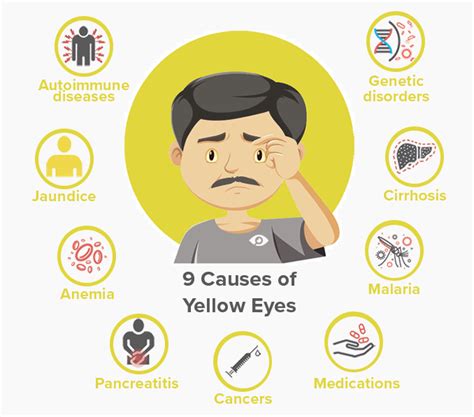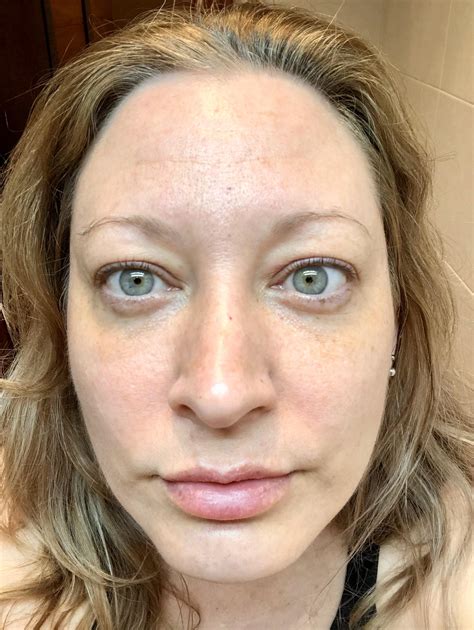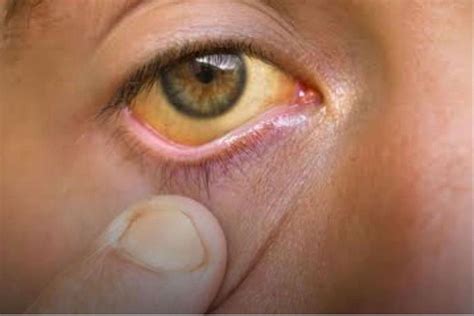Intro
Discover causes of yellow skin and eyes symptoms, including jaundice, liver disease, and bilirubin imbalance, and learn about diagnosis and treatment options for these conditions.
Yellow skin and eyes, also known as jaundice, is a common medical condition that can be caused by a variety of factors. The symptoms of jaundice can range from mild to severe and can be a sign of an underlying health issue. In this article, we will explore the importance of understanding yellow skin and eyes symptoms, and why it is crucial to seek medical attention if you or someone you know is experiencing these symptoms.
Jaundice is a condition characterized by a yellowish discoloration of the skin and eyes, which is caused by a buildup of bilirubin in the body. Bilirubin is a yellow pigment that is produced when the body breaks down old red blood cells. Normally, bilirubin is removed from the body by the liver, but if the liver is not functioning properly, bilirubin can build up and cause jaundice. Jaundice can be a sign of a underlying health issue, such as liver disease, bile duct obstruction, or hemolytic anemia.
Jaundice can affect anyone, regardless of age or sex. However, it is more common in newborns, as their livers are still developing and may not be able to remove bilirubin from the body efficiently. In adults, jaundice is often a sign of an underlying health issue, such as liver disease or bile duct obstruction. If left untreated, jaundice can lead to serious health complications, such as liver failure or even death.
Causes of Yellow Skin and Eyes

The causes of yellow skin and eyes can be divided into three main categories: pre-hepatic, hepatic, and post-hepatic. Pre-hepatic causes include conditions that affect the production of bilirubin, such as hemolytic anemia. Hepatic causes include conditions that affect the liver's ability to remove bilirubin from the body, such as liver disease or cirrhosis. Post-hepatic causes include conditions that affect the bile ducts, such as bile duct obstruction or pancreatic cancer.
Some common causes of jaundice include:
- Liver disease, such as hepatitis or cirrhosis
- Bile duct obstruction, such as gallstones or pancreatic cancer
- Hemolytic anemia, a condition where the body breaks down red blood cells too quickly
- Newborn jaundice, which is common in newborns due to their underdeveloped livers
- Certain medications, such as antibiotics or anti-inflammatory medications
Symptoms of Yellow Skin and Eyes

The symptoms of yellow skin and eyes can range from mild to severe and can include:
- Yellowish discoloration of the skin and eyes
- Fatigue or weakness
- Loss of appetite
- Nausea or vomiting
- Abdominal pain or tenderness
- Dark urine or pale stools
- Itching or pruritus
In newborns, the symptoms of jaundice can be more subtle and may include:
- Yellowish discoloration of the skin and eyes
- Lethargy or sleepiness
- Poor feeding or weight loss
- Vomiting or diarrhea
Diagnosis of Yellow Skin and Eyes
The diagnosis of yellow skin and eyes typically involves a physical examination, medical history, and laboratory tests. The doctor may perform a physical examination to look for signs of jaundice, such as yellowish discoloration of the skin and eyes. The doctor may also ask questions about the patient's medical history, such as any previous liver disease or bile duct obstruction.Laboratory tests may include:
- Blood tests to measure bilirubin levels
- Liver function tests to assess liver damage
- Imaging tests, such as ultrasound or CT scans, to visualize the liver and bile ducts
- Endoscopy or colonoscopy to visualize the bile ducts and pancreas
Treatment of Yellow Skin and Eyes

The treatment of yellow skin and eyes depends on the underlying cause of the condition. In some cases, jaundice may resolve on its own without treatment. However, in other cases, treatment may be necessary to manage the underlying condition and prevent complications.
Some common treatments for jaundice include:
- Medications to manage symptoms, such as itching or nausea
- Phototherapy, which involves exposure to special lights to help break down bilirubin
- Blood transfusions to replace red blood cells
- Surgery to remove gallstones or repair bile duct obstruction
- Liver transplantation in severe cases of liver disease
Prevention of Yellow Skin and Eyes
Preventing yellow skin and eyes involves managing the underlying causes of the condition. Some ways to prevent jaundice include: * Practicing good hygiene to prevent the spread of infections * Avoiding certain medications that can cause jaundice * Managing underlying medical conditions, such as liver disease or hemolytic anemia * Getting regular check-ups with a doctor to monitor liver function and detect any potential problems earlyComplications of Yellow Skin and Eyes

If left untreated, yellow skin and eyes can lead to serious health complications, such as:
- Liver failure, which can be life-threatening
- Bile duct obstruction, which can cause severe abdominal pain and vomiting
- Hemolytic anemia, which can lead to anemia and fatigue
- Pancreatic cancer, which can be life-threatening if left untreated
It is essential to seek medical attention if you or someone you know is experiencing symptoms of jaundice. Early diagnosis and treatment can help prevent complications and improve outcomes.
Living with Yellow Skin and Eyes
Living with yellow skin and eyes can be challenging, but there are ways to manage the condition and improve quality of life. Some tips include: * Practicing good hygiene to prevent the spread of infections * Managing underlying medical conditions, such as liver disease or hemolytic anemia * Getting regular check-ups with a doctor to monitor liver function and detect any potential problems early * Avoiding certain medications that can cause jaundice * Eating a healthy diet to support liver function and overall healthWhat are the common causes of yellow skin and eyes?
+The common causes of yellow skin and eyes include liver disease, bile duct obstruction, hemolytic anemia, newborn jaundice, and certain medications.
How is yellow skin and eyes diagnosed?
+Yellow skin and eyes are diagnosed through a physical examination, medical history, and laboratory tests, such as blood tests and imaging tests.
What are the treatment options for yellow skin and eyes?
+The treatment options for yellow skin and eyes depend on the underlying cause of the condition and may include medications, phototherapy, blood transfusions, surgery, and liver transplantation.
Can yellow skin and eyes be prevented?
+Yes, yellow skin and eyes can be prevented by managing underlying medical conditions, practicing good hygiene, avoiding certain medications, and getting regular check-ups with a doctor.
What are the complications of yellow skin and eyes if left untreated?
+If left untreated, yellow skin and eyes can lead to serious health complications, such as liver failure, bile duct obstruction, hemolytic anemia, and pancreatic cancer.
In conclusion, yellow skin and eyes is a common medical condition that can be caused by a variety of factors. It is essential to seek medical attention if you or someone you know is experiencing symptoms of jaundice. Early diagnosis and treatment can help prevent complications and improve outcomes. By understanding the causes, symptoms, diagnosis, treatment, and prevention of yellow skin and eyes, you can take the necessary steps to manage the condition and improve your quality of life. We encourage you to share this article with others, comment below with your thoughts and questions, and take the necessary steps to prioritize your health and well-being.
